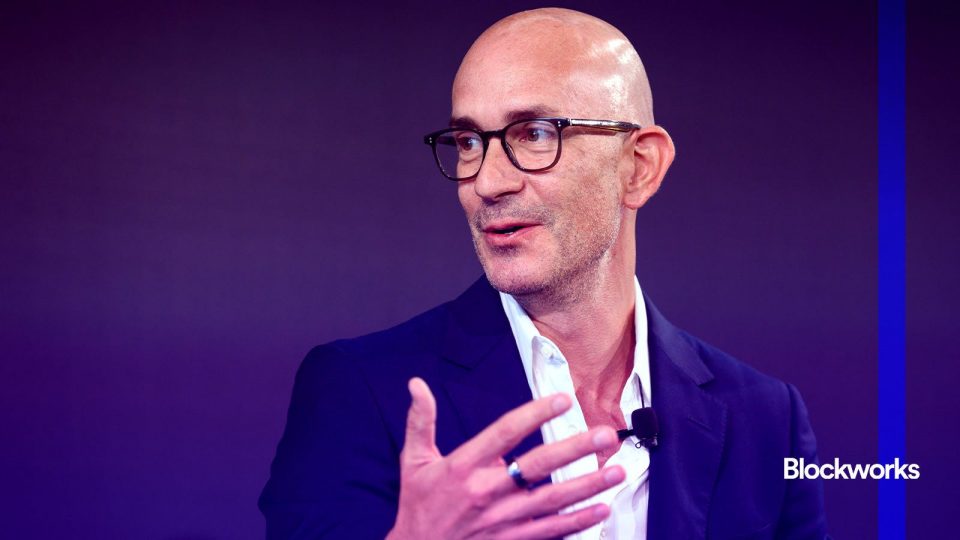Earlier this week, BlackRock’s BUIDL crossed $500 million — a milestone never before reached by a tokenized money market fund.
Tokenized funds have really taken off in the last few years, Securitize CEO Carlos Domingo told Blockworks. BlackRock and Securitize launched BUIDL earlier this year.
However, only some investors can access the fund. Qualified investors with more than $5 million in assets can subscribe through Securitize.
So what has led to this growth?
The rise of stablecoins is definitely a factor, because it made folks think about what else could be tokenized, Domingo said.
Read more: Circle debuts way to trade BlackRock tokenized fund shares for USDC
Right now the total value of the tokenized treasurys market, which includes BUIDL, sits at $1.8 billion. Domingo wouldn’t be surprised to see that market cap top $2 billion soon.
While the market is obviously far smaller than the $160 billion stablecoin market, “it’s definitely growing way faster than stablecoins.”
“Keep in mind, stablecoins are easier to purchase and use because they’re permissionless, while tokenized treasurys are securities. So they have some restrictions in terms of who can purchase them, how you can transfer them, etc. So they’re never going to be — in my opinion — as big as stablecoins…but I think they can easily become 10% to 20% of the market of stablecoins,” he said.
While the rest of the industry was no doubt buoyed by the launch of the bitcoin ETFs earlier this year, Domingo thinks the two have operated in “parallel paths.”
“The way I see it is: You’re taking a Web3 asset, which is bitcoin, and you put it on the [traditional finance] world through an ETF. Rather, I think tokenization is the opposite. You’re taking a [traditional finance] asset and you put it on the crypto — on the Web3 space — through tokenization. So they are like two distinct things that are very valuable but have nothing to do with each other,” he said.
Domingo discussed the conversations he’s been having with others in the space, noting that they’ve intensified since the launch of BUIDL.
“Every single asset manager out there is thinking about how they can participate,” he told me. Which is perhaps not surprising, given the appetite for BUIDL.
But that success isn’t only reserved for BlackRock.
According to rwa.xyz, Franklin Templeton’s fund, FOBXX, which was launched in April of last year, has topped $400 million — a 16% increase over the past 30 days. BUIDL, to put it in perspective, saw a nearly 9% jump in the same time period.
But Domingo thinks that BUIDL’s next $500 million could come even quicker — the fund just launched four months ago. Part of that may be because of some “new features,” he teased. Some will be unveiled in just a few weeks.
There’s also the fact that, because of the nature of the fund, there can be a bit of a delay when trying to subscribe to it.
He added, “In terms of onboarding entities, which — because these are institutions — takes time…for them to be able to invest in BUIDL. But we have a very big pipeline of entities being onboarded [so] that once they’re on board, they will invest, right?”
The success of BUIDL has led to discussions between BlackRock and Securitize about future projects. Domingo said that both firms are very aware that they’re only four months into BUIDL, so nothing else is coming at this point.
Read more: How the latest TradFi blockchain trial could mark the ‘five-yard-line’ for mass adoption
“So things take a longer time than [it would] take if we were working with a startup, which is fine because also you get the credibility of BlackRock…I think that in the next few months, we’re going to focus more on growing BUIDL in terms of the utility of the token, the functionality and the integration with all the parts of the ecosystem, rather than launching a new project,” he said.
But despite the desire to grow while working with a “small company” (Domingo says Securitize has 150 employees currently), he said that his firm isn’t looking to raise further funds any time soon. In May, ICYMI, BlackRock led a nearly $50 million round for the firm.
“We need to execute on what we have. We have plenty of money. We were not raising money when BlackRock came. We already had money in the bank. So it’s not that we needed the money…I think that raising money [has] been a massive distraction to me, particularly, because you talk to a lot of people, and at this point in time, I don’t want to raise more money,” Domingo said.
A shorter version of this article first appeared in Thursday’s Empire Newsletter. Sign up here to never miss an issue.
Start your day with top crypto insights from David Canellis and Katherine Ross. Subscribe to the Empire newsletter.
Explore the growing intersection between crypto, macroeconomics, policy and finance with Ben Strack, Casey Wagner and Felix Jauvin. Subscribe to the On the Margin newsletter.
The Lightspeed newsletter is all things Solana, in your inbox, every day. Subscribe to daily Solana news from Jack Kubinec and Jeff Albus.


